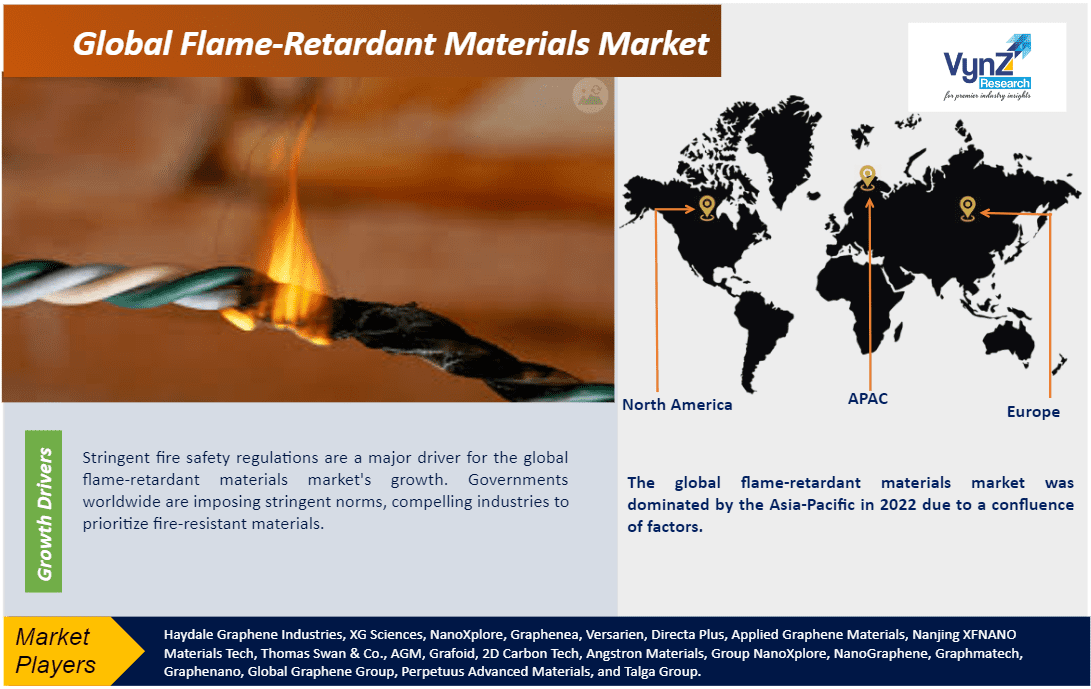Industry Overview
Flame-retardant materials are designed to inhibit or delay the spread of fire and are composed of substances that impede combustion by either releasing fire-extinguishing gases or forming a protective barrier. These materials undergo chemical treatments or incorporate specialized additives to enhance their fire resistance. When exposed to high temperatures, they react to suppress flames, reducing the likelihood of rapid-fire propagation. Commonly used in textiles, plastics, and construction materials, flame-retardants play a crucial role in enhancing safety in environments where fire risk is a concern; however, there is ongoing research to ensure these materials are effective while minimizing potential environmental and health impacts from their use.
Global flame-retardant materials market was worth USD 7.10 billion in 2023 and is expected reach USD 11.60 billion by 2030 with a CAGR of 5.45% during the forecast period, i.e., 2023-2030. Flame-retardant materials demand is rising due to stringent fire safety regulations, increasing awareness of fire hazards, expanding construction and automotive industries, and growing demand for electronics and electrical equipment, all necessitating fire-resistant materials to enhance safety and compliance.

Geographically, the market is expanding rapidly in North America, Europe and the Asia Pacific, as a result of the heightened awareness of fire hazards, robust industrial sectors, and a surge in construction activities demanding fire-resistant materials for enhanced safety and compliance; however, the market confronts constraints such as concerns over certain formulations, regulatory complexities, cost implications for manufacturers. Overall, the global flame-retardant materials market offers potential prospects for market participants to develop and fulfill the growing needs of wide range of industries including transportation, energy storage, consumer electronics, and other industries.
Flame Retardant Materials Market Segmentation
Insight by Type
Based on the type, the global flame-retardant materials market is segmented into Brominated, Nitrogen, Chlorinated, Phosphorous, Antimony Oxide, Aluminum Trihydrate, and others. In 2022, Aluminum Trihydrate dominated the global flame-retardant materials market due to its exceptional fire-retardant properties and widespread availability. Many key players in the industry have formed strategic partnerships and collaborations to secure a consistent supply chain of ATH. They've also established production plants in regions of high demand, bolstering their market presence. Additionally, substantial investments in research and development have led to innovations in ATH-based formulations, further solidifying its prominence. Its versatility, cost-effectiveness, and compliance with environmental regulations make it a preferred choice, driving its market dominance in fire-retardant applications across various industries.
Insight by Application
Based on the application, the global flame-retardant materials market is segmented into Polyolefin, Epoxy, PVC, Rubber, and others. In 2022, epoxy-based materials dominated the global flame-retardant materials market due to their exceptional fire-resisting properties. These materials possess high thermal stability, low flammability, and self-extinguishing capabilities, making them highly effective in preventing fire spread. Additionally, epoxies form durable, heat-resistant coatings, providing an added layer of protection and the versatility allows for application in diverse industries, including electronics, aerospace, and construction. Moreover, epoxy-based flame retardants can be tailored to meet specific fire safety standards, enhancing their appeal. With these properties, epoxies stand out as a crucial choice, driving their prevalence and dominance in the global flame-retardant materials market.
Flame-Retardant Materials Market Report Coverage
|
Report Metric
|
Details
|
|
Historical Period
|
2018–2023
|
|
Base Year Considered
|
2024
|
|
Forecast Period
|
2025 - 2030
|
|
Market Size in 2023
|
$7.10 Billion
|
|
Revenue Forecast in 2030
|
$11.60 Billion
|
|
Growth Rate
|
CAGR 5.45%
|
|
Segments Covered in the Report
|
By Type, and By Application
|
|
Report Scope
|
Market Trends, Drivers, and Restraints; Revenue Estimation and Forecast; Segmentation Analysis; Impact of COVID-19; Companies’ Strategic Developments; Market Share Analysis of Key Players; Company Profiling
|
|
Regions Covered in the Report
|
North America, Europe, Asia-Pacific, Middle East, and Rest of the World
|
Industry Dynamics
Flame Retardant Materials Market Growth Drivers
Stringent fire safety regulation
Stringent fire safety regulations are a major driver for the global flame-retardant materials market's growth. Governments worldwide are imposing stringent norms, compelling industries to prioritize fire-resistant materials. For instance, the EU's REACH regulation restricts hazardous substances in products, driving the adoption of safer flame-retardant alternatives. Additionally, recent regulations in construction and automotive sectors mandate the use of fire-resistant materials to enhance safety standards. This surge in demand has prompted significant investments in research and development, leading to advanced flame-retardant formulations. As a result, the global flame-retardant materials market experiences substantial expansion as industries aligns with these regulations to ensure heightened fire safety measures.
Demand from the construction industry
The burgeoning construction industry is a pivotal driver for the global flame-retardant materials market. As urbanization accelerates, there's an escalating demand for fire-resistant materials in building structures. Stringent regulations, like the US Building Codes and European Construction Products Regulation, mandate the incorporation of flame-retardant materials in construction. This compels builders and contractors to invest in fire-safe solutions to meet compliance standards. Additionally, the industry's shift towards sustainable and eco-friendly building materials further propels the demand for innovative, environmentally-conscious flame-retardant options. This convergence of regulatory pressure and industry trends underscores the pivotal role of the construction sector in propelling the flame-retardant materials market's growth.
Flame Retardant Materials Market Challenge
Transmission and Grid Integration
A significant challenge for the global flame-retardant materials market lies in the environmental impact of certain formulations. Some traditional flame-retardant compounds, like halogenated and organophosphorous formulations, can have adverse effects on ecosystems and human health. Their production and disposal contribute to pollution and pose potential risks. This has prompted a shift towards eco-friendly alternatives, driving research into more sustainable flame-retardant materials. Moreover, balancing fire safety with environmental concerns remains a crucial challenge, requiring ongoing innovation and regulation to ensure the market's sustainable growth while mitigating its environmental footprint. This transition represents a critical phase for the global flame-retardant materials market’s long-term viability and environmental stewardship.
Flame Retardant Materials Market Geographic Overview
The global Flame-retardant materials market is segmented into North America, Europe, the Asia-Pacific, and rest of the world region. The global flame-retardant materials market was dominated by the Asia-Pacific in 2022 due to a confluence of factors. Key industry players have forged strategic partnerships with local firms, ensuring a robust supply chain and have established production plants in proximity to burgeoning markets, optimizing production and distribution. Substantial investments in research and development lead to tailored solutions, addressing specific regional fire safety needs. For instance, in October 2023, LG Chem announced that they have developed a new flame-retardant material to prevent battery explosion. Moreover, a surge in demand from end-use industries, including electronics and construction, amplifies market growth. This dynamic interplay of partnerships, strategic investments, and burgeoning demand solidifies Asia-Pacific's pivotal role in propelling the flame-retardant materials market forward.
Flame Retardant Materials Market Competitive Insight
Clariant AG stands as one of the leading players in the global flame-retardant materials market. The Swiss specialty chemicals company has demonstrated its commitment to this sector through strategic investments and partnerships. Their Exolit product line, known for its high-performance flame-retardant solutions, has further solidified Clariant's position as an industry leader. Furthermore, Clariant has established production plants worldwide, including facilities in China and other Asian countries, bolstering its global presence and ensuring a robust supply chain. For instance, the company inaugurated a new flame-retardant production plant in China in October 2023. This concerted effort, coupled with a reputation for innovation and quality, reaffirms Clariant's pivotal role in providing cutting-edge flame-retardant solutions to diverse industries worldwide.
Albemarle Corporation is another leading player in the global flame-retardant materials market. Renowned for its extensive portfolio of specialty chemicals, Albemarle offers a range of flame retardants that cater to diverse industries. Their steadfast commitment is evident in strategic investments and partnerships, ensuring a robust supply chain and innovative solutions. Notably, Albemarle's Firemaster product line has become synonymous with high-performance flame-retardant solutions. With a global presence and production facilities strategically located, including plants in the US and Europe, Albemarle reinforces its status as a key player in the global flame-retardant materials market.
Recent Development by Key Players
In October 2023, Clariant inaugurated a new state-of-the-art production facility for halogen-free flame retardants in Daya Bay, Huizhou, as part of its China strategy with an investment of USD 67 million. The plant will provide flame-retardant for rapidly growing demand for innovative, sustainable fire protection in e-mobility and other applications. A second line is under construction and expected to be onstream in 2024, representing a further $44 million investment.
In October 2023, Avient launched new PTFE-free and non-halogen Cesa flame retardant additives to help producers of polycarbonate electrical & electronic (E&E) applications prepare for possible future PFAS restrictions. These new flame-retardant additives are part of Avient’s comprehensive portfolio of color and additives solutions.
Key Players Covered in the Report
Akzo Nobel, BASF SE, Chemtura Corporation, Clariant International Ltd., DOW, Eastman Chemical Company, Israel Chemicals Ltd, Albemarle Corporation, Hangzhou Lingrui Chemical Co. Ltd., Hongbaoli Group Co. Ltd., Huntsman International Llc, Lanxess AG, Muby Chemicals, Nabaltec AG, and Sasol Limited.
The Flame-retardant materials market report offers a comprehensive market segmentation analysis along with an estimation for the forecast period 2025–2030.
Segments Covered in the Report
-
Brominated
-
Nitrogen
-
Chlorinated
-
Phosphorous
-
Antimony Oxide
-
Aluminum Trihydrate
-
Others
-
Polyolefin
-
Epoxy
-
PVC
-
Rubber
-
Others
Region Covered in the Report
-
Germany
-
U.K.
-
France
-
Italy
-
Spain
-
Russia
-
Rest of Europe
-
China
-
Japan
-
Vietnam
-
India
-
South Korea
-
Rest of Asia-Pacific
Primary Research Interviews Breakdown
%20System%20Market.png)




%20System%20Market.png)